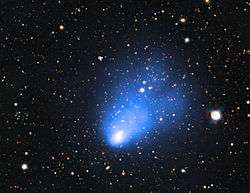El Gordo (galaxy cluster)
| ACT-CL J0102-4915 | |
|---|---|
|
El Gordo consists of two separate galaxy subclusters colliding at several million kilometres per hour. Credit: ESO/SOAR/NASA | |
| Observation data (Epoch J2000.0 [1]) | |
| Constellation(s) | Phoenix |
| Right ascension | 01h 02m 52.50s [1] |
| Declination | −49° 14′ 58.0″ [1] |
| Redshift | 0.87 [1] |
| Other designations | |
| El Gordo,[1] ACT-CL J0102-4915,[2] SPT-CL J0102-4915[2] | |
| See also: Galaxy groups, Galaxy clusters, List of galaxy clusters | |

El Gordo (lit. The Fat One) (ACT-CL J0102-4915 or SPT-CL J0102-4915) is the largest distant galaxy cluster observed at its distance or beyond, as of 2011. As of 2014, it still holds the record for being the largest distant galaxy cluster to have been discovered with a mass of 3 quadrillion suns.[3][4][5][6] It was found by NASA's Chandra X-ray Observatory, Atacama Cosmology Telescope - funded by National Science Foundation, and European Southern Observatory's Very Large Telescope.[7]
This galaxy cluster, officially named as, 'ACT-CL J0102-4915', has been given a 'nickname' by the researchers as 'El Gordo', which stands for "the Fat One" or "the Big One" in Spanish. It is located more than 7 billion light-years from Earth.[8]
The Astrophysical Journal has accepted the results for publication and will announce its findings and results on 'El Gordo' at its 219th meeting in Austin, Texas.[9]
Observations
Felipe Menanteau (then of Rutgers University) who led the study stated "this cluster is the most massive, the hottest, and gives off the most X-rays of any known cluster at this distance or beyond."[10]
Findings from the European Southern Observatory's Very Large Telescope and the Chandra X-ray Observatory show that El Gordo is composed of two separate galaxy subclusters, colliding at several million kilometers per hour.[11] These observations (using X-ray data and other characteristics) suggest that 'El Gordo' most probably formed in the same manner as the Bullet Cluster (which is located 4 billion light years from Earth).[12][13][14][15] According to Cristóbal Sifón from Pontifical Catholic University of Chile "this is the first time we've found a system like the Bullet Cluster at such a large distance."[16]
See also

References
- 1 2 3 4 5 "NAME El Gordo -- Cluster of Galaxies". SIMBAD.
- 1 2 "SPT-CL J0102-4915". NASA/IPAC Extragalactic Database.
- ↑ Guinness World Records 2014, Page 030.
- ↑ Boen, Brooke; Dunbar, Brian (16 April 2014). "Monster "El Gordo" Galaxy Cluster is Bigger Than Thought". NASA. Retrieved 17 April 2014.
- ↑ NASA, "El Gordo Galaxy Cluster", 10 January 2012 (accessed 7 July 2012)
- ↑ Monster NASA"Monster "El Gordo" Galaxy Cluster is Bigger Than Thought"
- ↑ CNN News 'Fat' galaxy cluster discovered 7 billion light-years away
- ↑ NASA's Chandra Finds Largest Galaxy Cluster in Early Universe
- ↑ These results on El Gordo are being announced at the 219th meeting of the American Astronomical Society in Austin, Texas
- ↑ Felipe Menanteau of Rutgers University in New Brunswick, N.J., who led the study
- ↑ CNN News El Gordo is made up of two separate galaxy subclusters
- ↑ http://www.sciencedaily.com/releases/2012/01/120110140423.htm
- ↑ El Gordo akin to the well-known object called the Bullet Cluster
- ↑ El Gordo most probably formed just like the Blue Cluster
- ↑ El Gordo akin to the well-known object called the Bullet Cluster
- ↑ Cristobal Sifon of Pontificia Universidad de Catolica de Chile (PUC) in Santiago
- ↑ "Hubble weighs "the fat one"". ESA/Hubble Picture of the Week. Retrieved 10 April 2014.
External links
- El Gordo Galaxy Cluster
- El Gordo: A 'Fat' Distant Galaxy Cluster
- El Gordo (ACT-CL J0102-4915): NASA's Chandra Finds Largest Galaxy Cluster in Early Universe
